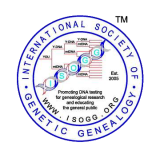Establishing a DNA geographical project
From ISOGG Wiki
Geographical projects (also known as heritage projects) provide a useful way to co-ordinate results from a particular region or country. One definite benefit of a geographical/heritage project is the ability to include mitochondrial DNA (mtDNA) and autosomal DNA results in the project.
There are four main types of geographical project:
- Y-DNA geographical projects collect Y chromosome DNA (Y-DNA) results
- mtDNA geographical projects collect mitochondrial DNA (mtDNA) results
- Dual geographical projects collect both Y-DNA and mtDNA results. Many dual projects also collect autosomal Family Finder DNA results
- Family Finder projects collect autosomal Family Finder DNA results for a specific region or country
The vast majority of large geographical projects are hosted at Family Tree DNA.
The first step is to check to see if a geographical DNA project has already been established. FTDNA projects can be searched from the project search menu. Even if a project DOES already exist for the region or ethnicity you desire, it may be possible to establish a separate project with FTDNA, if the existing project will not meet your goals.
In order to set up a project fill out the application form on the FTDNA website. Allow five business days for your application to be reviewed.
Recruit a co-admin, or several, for your project. Co-Admins can handle the project administration duties for you when you are on vacation, incapacitated, or unreachable for any other reason. Co-Admins can also assist by recruiting participants, providing website-building skills, language translation, promoting and endorsing the project, attending conferences, etc. Ideally, potential co-admins should be involved with the project and have an interest in the field of genetic genealogy.
If your project is established with Family Tree DNA, one of the first things to do, is enter as many surnames into the "Project Profile Page Surnames" fields as possible from the region or ethnicity. FTDNA's search field will return your project's listing as a "hit" for the surname entered, thus allowing them to join your project.
If your project is in a geographical locality or ethnicity that does not use English as their primary language, consider providing translated version of your website in the native language. this can be achieved by recruiting someone to translate your website, or linking to a web-based translator such as Google Translate.
To keep participants updated and informed on the status of the project, you may wish to create a mailing list or forum for the sharing of information. Examples: The Bahamas DNA Project participates in a Bahamian Genealogy and Culture Yahoo Group, and the Azores DNA Project utilizes a Rootsweb mailing list.
Other examples of items to include on your website: research and surname look-ups (see the French Heritage DNA Project for an example), the Puerto Rican DNA Project offers introductory genetics information, in addition to free look-ups in a genealogical database, and the Shetland DNA Project includes chronological historical information. You may also wish to include links to scientific studies that have been done on your ethnic group or country. A source for study abstracts can be found on the National Library of Medicine's PubMed site. Example: Aleutian Islands abstracts.
